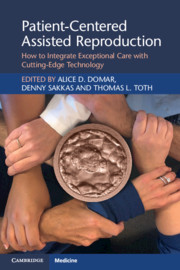 Patient-Centered Assisted Reproduction
Patient-Centered Assisted Reproduction Published online by Cambridge University Press: 02 March 2020
ART has made great advancements in the last several decades. From 3D sonographic imaging to assess for mullerian anomalies, to new medications and treatment protocols, the science of infertility treatment is constantly evolving. As technology improves, there continues to be a rising demand for fertility services. In fact, over eight million children worldwide have been born as a consequence of ART. However, despite these advancements, ART is available to only a small portion of the affected population. Numerous barriers prohibit many couples from accessing the services required to create a family.
To save this book to your Kindle, first ensure no-reply@cambridge.org is added to your Approved Personal Document E-mail List under your Personal Document Settings on the Manage Your Content and Devices page of your Amazon account. Then enter the ‘name’ part of your Kindle email address below. Find out more about saving to your Kindle.
Note you can select to save to either the @free.kindle.com or @kindle.com variations. ‘@free.kindle.com’ emails are free but can only be saved to your device when it is connected to wi-fi. ‘@kindle.com’ emails can be delivered even when you are not connected to wi-fi, but note that service fees apply.
Find out more about the Kindle Personal Document Service.
To save content items to your account, please confirm that you agree to abide by our usage policies. If this is the first time you use this feature, you will be asked to authorise Cambridge Core to connect with your account. Find out more about saving content to Dropbox.
To save content items to your account, please confirm that you agree to abide by our usage policies. If this is the first time you use this feature, you will be asked to authorise Cambridge Core to connect with your account. Find out more about saving content to Google Drive.